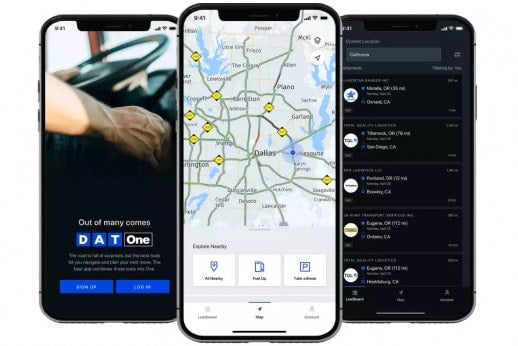Spot Freight
Spot Freight
To get started in spot trucking, you need a spot load board that helps find quality spot freight fast.
Spot market trucking is one of the hottest markets around. The DAT Load Board helps you quickly find quality spot freight, helping you build great partnerships and giving you the information you need to negotiate the best spot freight rates.
- Access the largest spot freight load board in the industry
- Understand market spot freight rates for better negotiations
- Get real-time alerts on matching spot market freight


Access the largest spot freight load board in the industry
Time is of the essence when it comes to spot shipping. Never miss a spot freight opportunity with the DAT Load Board.
Spot market trucking is all about finding the right load at the right time. As the biggest freight market in the industry, the DAT Load Board connects you with over 235 million new loads posted every year, helping connect you with spot freight loads that suit your equipment and schedule. Never miss a load with our best-in-class spot freight load board.
Understand market spot freight rates for better negotiations
The spot shipping market can be especially volatile, but the DAT Load Board can help you negotiate the best rate every time.
Spot freight rates depend on supply and demand and can fluctuate day-to-day or even hour-to-hour. That can make negotiating rates tough. But don’t sell yourself short! DAT Load Board offers you the most up-to-date information on spot market trucking conditions and truckload rates available so that you’re never over or underselling your spot freight rates. With DAT you can find higher paying spot market loads without the hassle!


Get real-time alerts on matching spot market freight
Save your favorite searches and set alerts so you never miss the perfect load on the spot market.
Spot market trucking can be tough since it requires carriers and owner-operators to stay constantly connected to their load boards so that they never miss out on a lucrative spot trucking opportunity. For smaller carriers and independent owner-operators, that can prove challenging, but it doesn’t have to.
With the DAT One Mobile App, you can get alerted every time a new load matching your search criteria gets posted to the load board. That way you can focus on the road ahead knowing you’ll stay in the loop about the latest spot market freight loads.
The term “spot freight” was originally used to describe “on the spot” decisions made about freight that needed to be moved immediately. And while spot trucking is still used for freight that needs to be hauled quickly, it is increasingly also being used for “end-to-end” jobs that include picking up international freight, transporting that freight to another port, then picking up and hauling spot freight to its final destination.
Spot freight is distinct from contract freight because a spot freight contract usually only covers a single job, while contracts typically include multiple jobs over a set period of time.
As opposed to contract shipping, in which companies agree to a set rate for their shipping needs over a period of usually 12-24 months, spot freight rates are agreed upon “on the spot,” usually for a single job. And while some of these arrangements are made well in advance, spot freight trucking is still often used to expedite shipments or in cases of emergency, like natural disasters. Recent supply chain issues have also made spot freight a more popular solution.
Because spot freight rates are typically for individual jobs and are usually negotiated closer to the delivery date, they are heavily affected by market factors like supply and demand. The best way to attain the best rates during negotiations is to go in armed with accurate market rate data.
The nature of spot market trucking means that spot shipping can be especially volatile. Spot freight rates depend heavily on supply and demand. If there is a large demand for expedited spot shipping and very few trucks available, rates will be higher. However, if only a few shippers need spot trucking services, prices will likewise drop considerably.
As a carrier or owner-operator, it’s typically best to use a combination of contract freight and spot market freight to get the best possible rates.